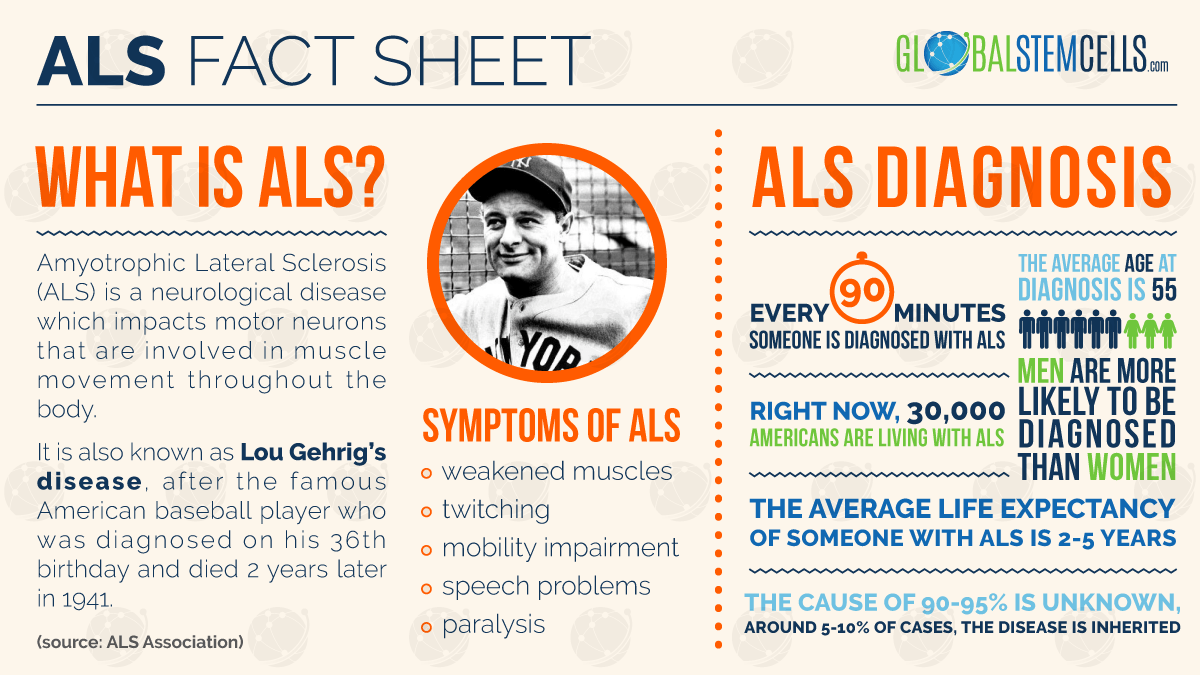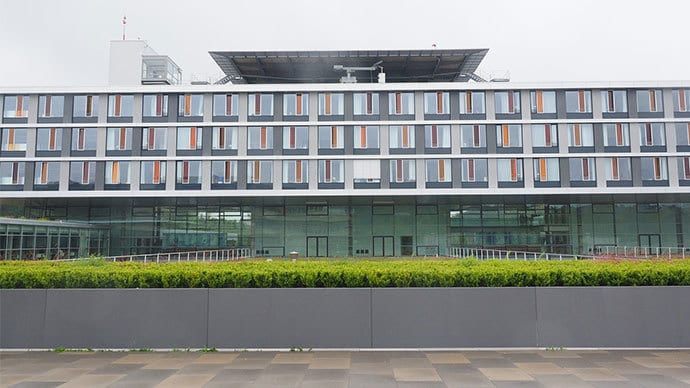Amyotrophic Lateral Sclerosis (ALS) is a rare disease that mainly involve the nerve cells responsible for controlling the voluntary movement of muscles. ALS specifically attacks motorneurons in the brain stem, cortex and the spinal cord thereby causing effects such as muscle weakness, spasticity and paralysis. People affected by ALS experience difficulties in performing everyday functions like walking, breathing and talking. ALS is degenerative and it gradually causes a degeneration of motor neurons, leading to their death, and eventually leading to paralysis and death of the victim. This is usually within 3 to 5 years of initial diagnosis. Most of the victims of this disease die of respiratory complications as a result of the progressive weakening of the patient’s respiratory functions.
ALS Incidence
According to the Johns Hopkins Medicine, statistics show that ALS affects up to 30,000 patients in the United States of America with about 5,000 new cases being diagnosed every year. It is responsible for as many as five out of every 100,000 deaths of people aged 20 years or older. ALS indeed is a mystical disease as it is not easy to pinpoint the exact causes of ALS as it has no clear identifying cause. ALS does not impair a person’s intellectual reasoning, vision, hearing or sense of taste, smell and touch.

ALS is also known as Lou Gehrig’s disease and has no known cure. It was first discovered by French neurologist Jean-Martin Charcot in the year 1869, but became more noticeable in the year 1939 after one of baseball’s most famous stars in the United States Lou Gehrig was diagnosed with it. Fans noticed that Lou Gehrig, once a very formidable baseball player had suddenly lost his touch and eventually pulled out of one of the games. He passed away barely two years after the first symptoms of ALS were noticed.
One of the most famous modern scientists, Prof. Stephen Hawking is known to suffer from the motor neuron disease. His doctors had believed that he would be dead within a few years. He requires a motorized wheelchair to move around as he is paralyzed. He also communicates through a special computer which he controls with a muscle on his cheek. Hawking’s case has defied a lot of theories on ALS as he is still alive almost 50 years after he was first diagnosed with it.
ALS can be further classified into two categories: sporadic and inherited. Sporadic cases of ALS occur in up to 90% of all reported cases, while about 10% is inherited from family members. The disease usually starts around the age of 60 and in inherited cases it starts at around the age of 50.
ALS Research
Research for the cure of ALS has been ongoing for quite a number of years. Scientists have proposed and tested many therapies and treatments, but the mortality rate due to effects of ALS still remains at almost 100%. All victims of ALS have succumbed to the debilitating disease.
The advancement of technology has enabled researchers to explore and study the disease, its effects and possible remedial cures to help decrease this mortality rate. Researchers have come up with Stem Cell-based Therapies that could eventually be used as a cure for ALS. This document will explore the use of Stem Cell-based therapies to treat the disease and also discuss what this advancement could mean for ALS patients in the near future.
Recently, Stem Cell-based Therapies, as potentially effective treatments of ALS, have emerged employing intraspinal, intrathecal, intramuscular, intracerebral, or intravenous autologous Stem cell administration routes.
Mesenchymal Stem cells
Mesenchymal Stem cells (MSCs) are multipotent adult stem cells that are present in all tissues. MSCs can differentiate into different tissues (meaning they can produce more than one type of specialised cell of the body) ranging from mesoderm, ranging from Osteocytes (bone cells), Chondrocytes (cartilage cells) and Adipocytes (fat cells). It has also been shown that MSCs could be pluripotent meaning that they can also differentiate into tissues and cells of non-mesodermal origin like neurons and epithelial cells.
MSCs can differentiate into many different types of cells that do not belong to the skeletal tissues, such as nerve cells, heart muscle cells and liver cells, which form the inner layer of blood vessels, and can therefore be used in the repair inured cell tissues of other cells of a different type.
Human undifferentiated Mesenchymal Stem Cells (hMSCs) can be harvested from different sources. They can be gotten from the bone marrow, the umbilical cord blood, adipose, and Wharton’s jelly. These cells have been tested in rodent models to treat diseases such as ALS and Spinal Cord Injury. Many studies have shown that the administration of human undifferentiated Stem cells is safe and can delay motor function and can increase the life expectancy of the subjected patients.
MSC and ALS Research
One test has increased worldwide interest in stem cell based ALS treatment. A group of scientists based in the Czech Republic performed a clinical trial in ALS patients to assess the safety and effectiveness of the administration of autologous bone marrow Stem Cell Therapy in a group of patients suffering from ALS.
In this particular test, bone marrow derived Mesenchymal Stem cells were used to assess the safety and efficacy of a single intrathecal administration of autologous Bone Marrow Mesenchymal Stem cells (BM-MSCs) in ALS treatment of patients with ALS. This trial was approved by the State Institute for Drug Control and the informed consent form approved by the ethics committee of the University Hospital Motol in Prague, Czech Republic.
The study was conducted at the Department of Neurology, University Hospital Motol.
All subjects entering the study gave an informed consent before any procedures specified in the protocol were performed on them. The patients were assured that the procedures involved in the study protocol would not interfere with the standard method of care and treatment.
A group of 26 people with symptoms of ALS were enrolled to participate in this program, and out of these 23 were found suitable for efficacy evaluation. These subjects were prescreened for a period of six months before Stem Cell Transplantation was performed. They were examined three times at 6, 3 and 1 month before treatment in order to check the progression rate of the disease. After that, they were also examined at regular intervals at 3, 6, 9, 12 and 18 months to assess the safety and effectiveness of the administered treatment.
Potential and adverse effects of this therapy were assessed during this period and the outcome was evaluated by the ALS Functional Rating Scale (ALSFRS).
The Amyotrophic Lateral Sclerosis Functional Rating Scale (ALSFRS) is an instrument for evaluating the functional status of patients with Amyotrophic Lateral Sclerosis. It can be used to monitor functional change in a patient over time. Such measures as speech, swallowing, handwriting walking and breathing are measured and compared over time.
The forced vital capacity and weakness scales of these patients were also assessed. Bone marrow derived stem cells were administered through a method known as intrathecal application where the bone marrow derived Stem cells are injected into the spinal theca. This is the area in the spinal cord that hold the cerebrospinal fluid. The implanted cells spread without crossing the blood-brain barrier.
Objectives of the Study
One of the primary objectives of this study was to assess the safety of the treatment to patients. All patients’ complaints regarding their medical conditions were recorded. They were monitored for reactions such as allergies, fever and any abnormal pains. Any bleeding, new infections and paralysis during the treatment were also recorded.
While in hospital, the patients’ temperature, blood pressure and any other vital functions were observed and recorded on a daily basis. If no further complications were observed the patients were discharged. 30% of these patients experienced mild to moderate headaches. No other serious adverse reactions were reported from this group.
The other objective of the trial was to evaluate the effect of the transplantation on the rate of disease progression pre and post treatment. The changes in ALSFRS after treatment were compared to the changes observed prior. The result of this was that there was a significant stabilisation of ALSFRS score in the patients. Tests after 6 months showed a marked slowdown in disease progression.
Conclusion from the Study
From the results of these tests, it can be concluded that intrathecal application of BM-MSC is ALS patients is a relatively safe procedure and can slow down the progression of the disease.
It also might be important to start the therapeutic intervention much earlier, similar to animal models, but this would require earlier ALS diagnosis and/or identification of early disease markers in suspected cases. There is a need for further clinical trials to elucidate the most effective cell type, the most effective methods of delivery, and proper doses in single or repeated applications.
Such positive results show that a lot of progress has been made show that ALS can be contained and this gives a lot of hope to the victims of ALS in the coming future.
Stem Cell Treatment for ALS Available Today
We are excited to offer Stem Cell Therapy at our state of the art facilities to stop the progression of ALS in our patients.
We have a dedicated team of highly skilled doctors, nurses and other practitioners based in our world class medical facility in Bangkok, Thailand. They work around the clock to ensure our patients comfort and welfare before, during and after treatment is of world class standard.
Our patients, who come from around the world, are a testimony to the fact that they have been able to notice a change in the way their bodies respond to treatment. To ensure that our patients get the best out of the Stem Cell-based Therapy, we administer a combination of supportive remedies such as injection of growth factors and vitamins, rehabilitation and detoxification programs to treat them.
The treatment also includes dietary advice, Occupational Therapy, Physical Therapy and Aquatic Therapy. Acupuncture and ultrasound techniques also used. As our patients will testify, this combination of treatments have since worked for them remarkably well.
H/T: Ingenta




 English
English